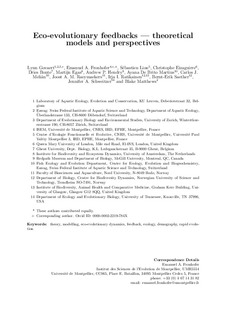| dc.contributor.author | Govaert, Lynn | |
| dc.contributor.author | Fronhofer, Emanuel A. | |
| dc.contributor.author | Lion, Sébastien | |
| dc.contributor.author | Eizaguirre, Christophe | |
| dc.contributor.author | Bonte, Dries | |
| dc.contributor.author | Egas, Martijn | |
| dc.contributor.author | Hendry, Andrew P. | |
| dc.contributor.author | Martins, Ayana de Brito | |
| dc.contributor.author | Melian, Carlos J. | |
| dc.contributor.author | Raeymaekers, Joost A. M. | |
| dc.contributor.author | Ratikainen, Irja Ida | |
| dc.contributor.author | Sæther, Bernt-Erik | |
| dc.contributor.author | Schweitzer, Jennifer A. | |
| dc.contributor.author | Matthews, Blake | |
| dc.date.accessioned | 2019-04-04T13:09:29Z | |
| dc.date.available | 2019-04-04T13:09:29Z | |
| dc.date.created | 2019-01-15T17:50:02Z | |
| dc.date.issued | 2018 | |
| dc.identifier.citation | Functional Ecology. 2018, 33 13-30. | nb_NO |
| dc.identifier.issn | 0269-8463 | |
| dc.identifier.uri | http://hdl.handle.net/11250/2593364 | |
| dc.description.abstract | Theoretical models pertaining to feedbacks between ecological and evolutionary processes are prevalent in multiple biological fields. An integrative overview is currently lacking, due to little crosstalk between the fields and the use of different methodological approaches.
Here, we review a wide range of models of eco‐evolutionary feedbacks and highlight their underlying assumptions. We discuss models where feedbacks occur both within and between hierarchical levels of ecosystems, including populations, communities and abiotic environments, and consider feedbacks across spatial scales.
Identifying the commonalities among feedback models, and the underlying assumptions, helps us better understand the mechanistic basis of eco‐evolutionary feedbacks. Eco‐evolutionary feedbacks can be readily modelled by coupling demographic and evolutionary formalisms. We provide an overview of these approaches and suggest future integrative modelling avenues.
Our overview highlights that eco‐evolutionary feedbacks have been incorporated in theoretical work for nearly a century. Yet, this work does not always include the notion of rapid evolution or concurrent ecological and evolutionary time scales. We show the importance of density‐ and frequency‐dependent selection for feedbacks, as well as the importance of dispersal as a central linking trait between ecology and evolution in a spatial context. | nb_NO |
| dc.language.iso | eng | nb_NO |
| dc.publisher | Wiley | nb_NO |
| dc.title | Eco-evolutionary feedbacks - theoretical models and perspectives | nb_NO |
| dc.type | Journal article | nb_NO |
| dc.type | Peer reviewed | nb_NO |
| dc.description.version | acceptedVersion | nb_NO |
| dc.source.pagenumber | 13-30 | nb_NO |
| dc.source.volume | 33 | nb_NO |
| dc.source.journal | Functional Ecology | nb_NO |
| dc.identifier.doi | 10.1111/1365-2435.13241 | |
| dc.identifier.cristin | 1657645 | |
| dc.description.localcode | Locked until 14.11.19 due to copyright restrictions. This is the peer reviewed version of an article, which has been published in final form at [10.1111/1365-2435.13241]. This article may be used for non-commercial purposes in accordance with Wiley Terms and Conditions for Self-Archiving. | nb_NO |
| cristin.unitcode | 194,66,10,0 | |
| cristin.unitname | Institutt for biologi | |
| cristin.ispublished | true | |
| cristin.fulltext | postprint | |
| cristin.qualitycode | 2 | |
